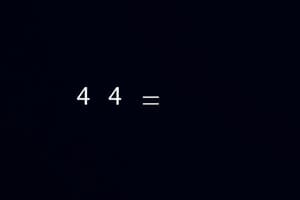Podcast
Questions and Answers
What defines a unit vector?
What defines a unit vector?
- A vector representing the position of a point in space.
- A vector that can be expressed in component form only.
- A vector with a magnitude of one and indicating direction. (correct)
- A vector that has zero magnitude.
Which vector operation results in a scalar?
Which vector operation results in a scalar?
- Dot product (correct)
- Vector addition
- Cross product
- Vector subtraction
What is the main characteristic of a zero vector?
What is the main characteristic of a zero vector?
- It is always represented as (1,0).
- It has a magnitude greater than one.
- It has a defined direction.
- It has zero magnitude and no specific direction. (correct)
Which statement about vector addition is true?
Which statement about vector addition is true?
How do you denote a position vector in mathematical form?
How do you denote a position vector in mathematical form?
What does scalar multiplication of a vector change?
What does scalar multiplication of a vector change?
What is the result of the cross product of two parallel vectors?
What is the result of the cross product of two parallel vectors?
Which property states that (A + B) + C = A + (B + C)?
Which property states that (A + B) + C = A + (B + C)?
What is not typically an application of vectors?
What is not typically an application of vectors?
What does the angle θ represent in the dot product formula?
What does the angle θ represent in the dot product formula?
Flashcards are hidden until you start studying
Study Notes
Definition of Vectors
- Vectors are quantities that have both magnitude and direction.
- Examples: displacement, velocity, acceleration, and force.
Representation of Vectors
- Typically represented as arrows:
- Length indicates magnitude.
- Direction of the arrow indicates direction.
- Can also be represented mathematically in component form: A = (Ax, Ay) in a 2D plane.
Types of Vectors
- Zero Vector: Has zero magnitude and no specific direction.
- Unit Vector: Has a magnitude of one and indicates direction. Denoted as u = A/|A|.
- Position Vector: Represents the position of a point in space relative to an origin.
Vector Operations
-
Addition:
- Can be added geometrically (tip-to-tail method) or algebraically.
- Resultant vector R = A + B.
-
Subtraction:
- A - B = A + (-B).
-
Scalar Multiplication:
- Multiplying a vector by a scalar changes its magnitude but not its direction.
- For vector A and scalar k: kA = (kAx, kAy).
-
Dot Product:
- A scalar product defined as A · B = |A||B|cos(θ), where θ is the angle between them.
- Useful for finding the angle between vectors or determining orthogonality.
-
Cross Product:
- A vector product defined as A × B = |A||B|sin(θ) n, where n is the unit vector perpendicular to the plane formed by A and B.
- Used to find a vector perpendicular to two given vectors.
Properties of Vectors
- Vectors can be:
- Equal if they have the same magnitude and direction.
- Added or subtracted according to commutative (A + B = B + A) and associative properties ((A + B) + C = A + (B + C)).
Applications of Vectors
- Essential in physics for describing motion, forces, and fields.
- Used in engineering to analyze forces and structural design.
- Important in computer graphics for modeling and animation.
Definition of Vectors
- Vectors combine both magnitude and direction.
- Common examples of vectors include displacement, velocity, acceleration, and force.
Representation of Vectors
- Vectors are typically visualized as arrows.
- The length of the arrow indicates the magnitude.
- The direction of the arrow conveys the vector's direction.
- Vectors can also be expressed mathematically in component form, such as A = (Ax, Ay) for a two-dimensional plane.
Types of Vectors
- Zero Vector: Lacks magnitude and direction.
- Unit Vector: Has a magnitude of one and indicates direction. Expressed as u = A/|A|.
- Position Vector: Describes the location of a point in space relative to an origin.
Vector Operations
- Addition:
- Vectors can be combined geometrically using the tip-to-tail method or algebraically.
- The resultant vector is given by R = A + B.
- Subtraction:
- Vector subtraction can be expressed as A - B = A + (-B).
- Scalar Multiplication:
- Scaling a vector by a scalar changes its magnitude but retains its direction.
- For vector A and scalar k, the operation is represented as kA = (kAx, kAy).
- Dot Product:
- This scalar product is defined as A · B = |A||B|cos(θ), with θ as the angle between the two vectors.
- It serves to calculate the angle or determine orthogonality between vectors.
- Cross Product:
- This vector product is defined as A × B = |A||B|sin(θ) n, where n is the unit vector perpendicular to both A and B.
- Crucial for identifying a vector that is perpendicular to two given vectors.
Properties of Vectors
- Vectors are considered equal if their magnitudes and directions match.
- Commutative property: A + B = B + A.
- Associative property: (A + B) + C = A + (B + C).
Applications of Vectors
- Vectors are vital in physics for describing concepts such as motion, forces, and fields.
- In engineering, they help analyze forces and inform structural design.
- In computer graphics, vectors are used for modeling and animation work.
Studying That Suits You
Use AI to generate personalized quizzes and flashcards to suit your learning preferences.




